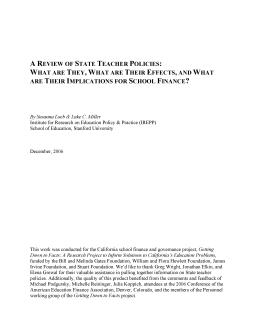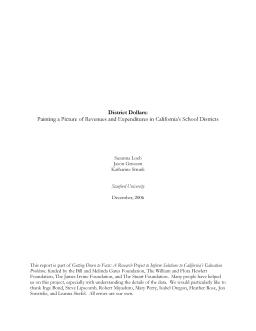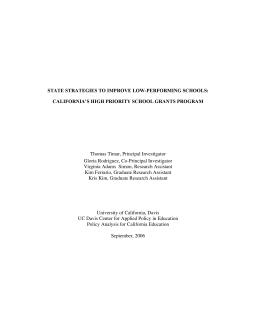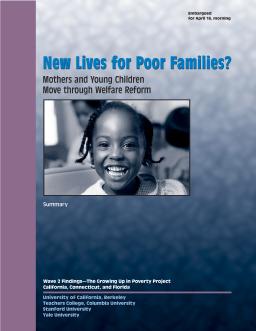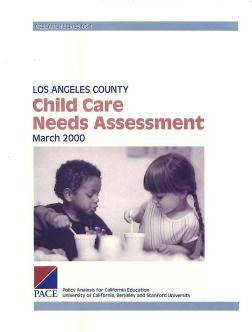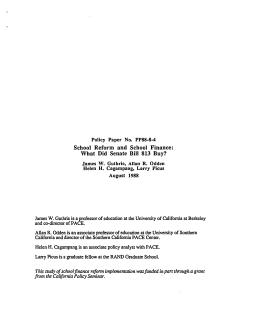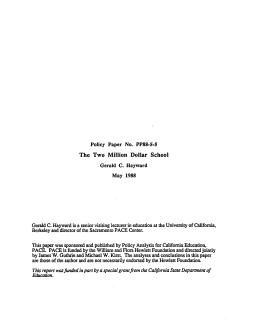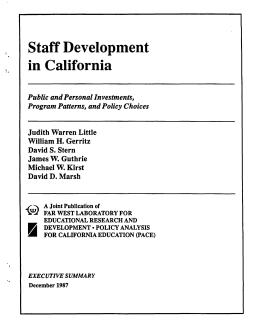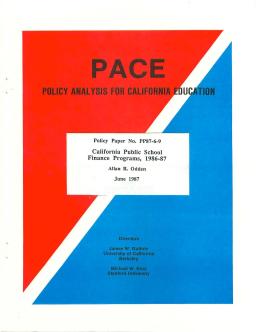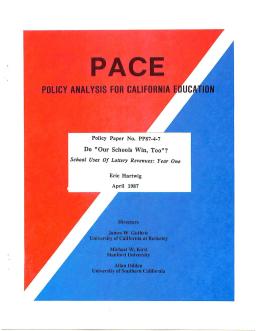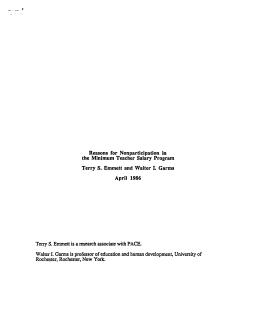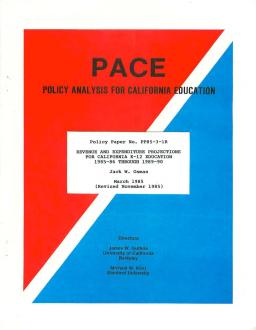Published
Summary
This report focuses on estimating the costs for California school districts to meet state-set achievement goals and how these costs differ across districts with different student characteristics. The study uses an econometric cost function approach to estimate base costs and marginal costs associated with poverty, English learners, and special education. The findings are compared with cost studies in other states and used to analyze whether the current school finance system appropriately accounts for cost differentials across districts.
What Are Their Effects, and What Are Their Implications for School Finance?
Published
Summary
The report explores the impact of teacher sorting, or the tendency for high-achieving students to be assigned to more effective teachers, on student achievement. It finds that teacher sorting has a significant positive effect on student achievement in both math and English language arts. The effects are particularly strong for students who start out low-achieving. The report argues that policies aimed at reducing teacher sorting, such as random assignment of students to teachers, may be counterproductive for student achievement.
Painting a Picture of Revenues and Expenditures in California’s School Districts
Published
Summary
The report explores the relationship between teacher experience, school characteristics, and student achievement. Teacher experience is positively associated with student achievement, particularly in schools with high concentrations of low-income students. Additionally, the authors find that school size, teacher turnover, and teacher qualifications also impact student achievement. The report concludes that policies aimed at improving teacher quality and experience can have positive effects on student outcomes, particularly in high-poverty schools.
California's High Priority School Grants Program
Published
Summary
The report examines the effectiveness of a large-scale performance-based incentive program in California schools. Results show that the program had a small but positive impact on student test scores in math and English, with larger effects in schools with high levels of poverty. However, the authors caution that incentive programs may have unintended consequences and should be implemented with care.
Mothers and Young Children Move Through Welfare Reform
Published
Summary
This report discusses the lack of knowledge about the impact of welfare-to-work programs on young children since 1996, and how policy leaders are debating ways to aid jobless mothers and enrich their children's lives. The project team followed 948 mothers and preschool-age children for two to four years after the women entered new welfare programs in California, Connecticut, and Florida.
Mothers and Young Children Move Through Welfare Reform: Executive Summary
Published
Summary
This report examines how welfare-to-work programs have affected the lives of young children since 1996, and how they've impacted the home and childcare settings in which they are raised. The study followed 948 mothers and preschool-age children in California, Connecticut, and Florida for two to four years, using interviews, assessments, and visits to homes and childcare settings. The report highlights the major findings from the study.
Published
Summary
A study conducted for the Los Angeles County Department of Public Social Services aimed to determine the supply and demand of licensed childcare in the county, with a focus on low-income communities and special types of care. The survey analyzed data at three levels: county-wide, service planning areas, and supervisorial districts. Results showed disparities in childcare supply across the county, with shortages in special types of care and little information on where childcare is needed.
California's School Voucher Initiative—Proposition 38
Published
Summary
Proposition 38 allows parents in California to obtain a state chit worth $4,000 and move their child from public to private school, which would significantly affect school financing. This policy brief addresses six key questions about the proposal, including its differences from the 1993 voucher initiative, which families would benefit, how it would impact school spending and taxpayers, and the success of voucher experiments in raising achievement.
Published
Summary
California's growing child population will require significant increases in public spending, particularly in education due to immigration, working parents, poverty, and family disorganization. Counties and school districts bear the brunt of providing children's services, but cities have greater fiscal flexibility and revenue-raising potential. This paper provides information on county children's services and trends in county budgets to support further research on county financing for children's services.
1960 to 1988
Published
Summary
Public school funding in the US has seen continuous increases in real funding since 1960, reflecting strong citizen support for public schools and a growing economy. Despite pessimism and recession in the 1980s, real school funding continued to increase substantially. This report provides an overview of school revenues and funding increases needed for education reforms, and details changes in education finance during the 1980s, comparing increases to the levels needed to fund proposed reforms.
What Did Senate Bill 813 Buy?
Published
Summary
California's K-12 schools are supported by a vast amount of public money, and education financing has become an intensely political issue. This report analyzes school financing outcomes, including equity, efficiency, distributional consequences, and academic rigor, and addresses the conditions of school finance equality. The report seeks to provide answers to important questions about the amount of money being spent, how it compares to other states, who benefits from the funding, and whether added state funds have bought more rigorous schooling.
Published
Summary
In 1987, the Superintendent of Public Instruction released a document detailing the average costs of California schools for 1985-86, providing a brief summary of school expenditures. However, this report lacks in detail, and this report aims to provide more comprehensive and realistic data on school expenditure patterns. The report serves as an analytical base for exploring issues surrounding school expenditures in California, and the data was provided by the state Department of Education staff.
Public and Personal Investments, Program Patterns, and Policy Choices—Executive Summary
Published
Summary
The California Staff Development Policy Study was initiated to assess the possibilities and limitations of staff development in improving classroom teaching and learning. The study aims to answer four questions related to California's investment in staff development, how staff development activities are administered, and how teachers and administrators judge their effectiveness. The study yields eight main conclusions, presented in terms of investment and focusing on improving the capacities and commitments of California's educators.
Published
Summary
This report provides an overview of California's school finance system, including selected school finance facts; descriptions of the general revenue limit and categorical programs funding formulas; and, for each program, the amount appropriated for 1986-87, the number of districts participating, and number of students served.
School Uses of Lottery Revenue—Year One
Published
Summary
The report discusses the implementation and impact of California's State Lottery. During its first year of operation, the lottery generated $1.77 billion in ticket sales, with $689 million going towards public education. However, the article highlights the uncertainty surrounding the use of these funds and concerns about the reliability of the lottery as a source of education revenue. The study surveyed California K-12 public school districts regarding their use of lottery revenues and attitudes towards the program.
1985–86 Evaluation Report
Published
Summary
Peninsula Academies are three-year high school programs designed for at-risk students, combining academic and technical training. Since 1981, they've been operating in California, and in 1985, ten new programs were created under state sponsorship. This report evaluates the quality of implementation and evidence of measurable impact on students after the first year. The report is based on site visits, questionnaire responses, and student data gathered from each high school. The Academy model is complex, but some sites didn't fully realize all components.
Published
Summary
California's K-12 education system has experienced funding instability, with revenues per pupil fluctuating and staying constant for years. The education system is attempting a major program of quality improvements while keeping funding constant, a challenge that may be difficult to maintain in the future. The state gives K-12 education a lower priority than most other states when state revenues are tight. The state needs an additional $7.2 billion in the next five years to maintain the current level of real resources per pupil.
Published
Summary
This study investigates low participation in the Minimum Teacher Salary provision of SB 813, which had previously been reported by the Legislative Analyst. Only a small percentage of funds were claimed for 1983-84 and 1984-85. Researchers surveyed 48 districts in CA, showing a potential mean beginning salary of over $19K by 1985-86. The concern about underparticipation may be unfounded, as a large percentage of districts will participate, while those that do not have reasons. Large districts participate more than small and medium sized ones, and participation in rural areas is increasing.
Waivers and School-Based Program Coordination Under AB 777
Published
Summary
California's waiver authority provides school districts relief from Education Code, allowing them to seek alternatives to state requirements subject to local and state review. Waivers are automatically approved unless denied by the State Board of Education, which rarely happens over local objections. Program waivers are rare despite clamor for needed flexibility, possibly due to districts being unaware of the process, viewing it as time-consuming, or using suboptimal local procedures. Oversight hearings are recommended to explore the potential of the waiver process.
1985–86 Through 1989–90
Published
Summary
Expenditures for elementary and secondary education in California must rise by about 59 percent between 1983–84 and the end of the decade just to maintain the status quo in terms of real per-student spending. This would amount to a K–12 budget in 1989–90 of $21.9 billion. Yet K–12 revenues are projected to grow by only 50 percent (under one scenario) or by about 72 percent (under another). In other words, unless the revenue structure is significantly altered, projected school revenues through 1990 will be inadequate to maintain the same level of spending per student or will increase at a pace...

